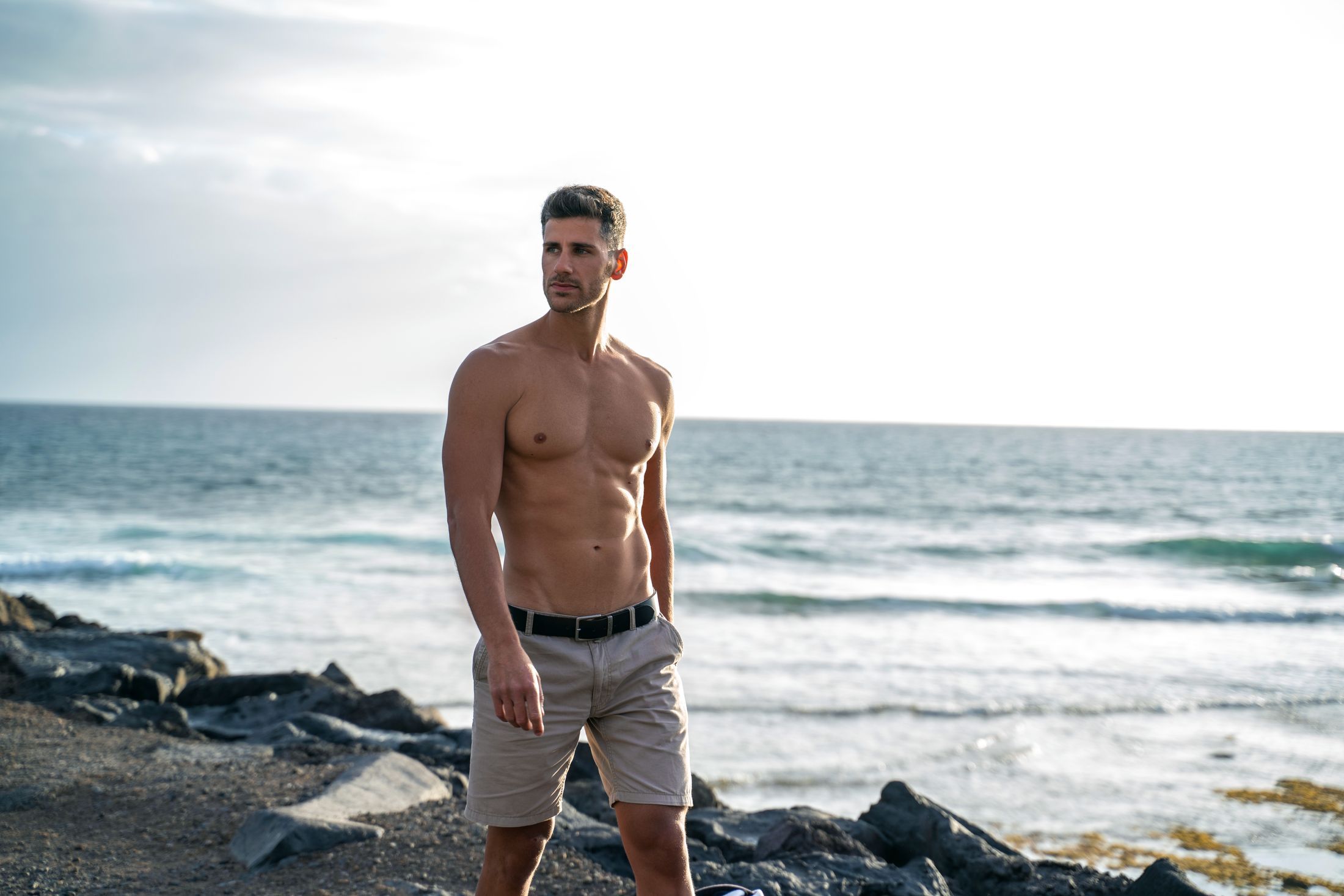

Men can feel self-conscious about their bodies for many reasons, including excess fat accumulation at their chest.
Men are able to achieve a more athletic and firm appearance with Male Breast Reduction (gynecomastia) surgery. Houston board-certified plastic surgeon Dr. Ravi Somayazula helps men regain their confidence and a masculine, well-built chest with male breast reduction surgery.
Gynecomastia Surgery Can Correct:
“Men are becoming an increasingly larger demographic of patients undergoing plastic surgery today. Many work hard with diet and exercise to achieve a chiseled physique, but certain limitations prevent them from achieving their desired result. There are many options I can offer to decrease unwanted breast fat in men in order to achieve better definition in their chest and torso.”
– Dr. Ravi Somayazula
1 of 8

Dr. Ravi Somayazula and your patient care coordinator will spend ample time during the initial consultation discussing the various options and techniques tailored specifically to you.
While keeping your expectations in mind, goal chest size and shape will be discussed. A thorough examination of the chest will be performed to evaluate the current size, shape, skin elasticity, and location of the nipples. Dr. Ravi Somayazula will determine what he believes to be the optimal type of male breast reduction (gynecomastia) surgery to help you get to your goal. At Body By Ravi Plastic Surgery & Aesthetics in Houston, our board-certified plastic surgeon performs male breast reduction through liposuction alone, liposuction and skin excision, as well as liposuction with the removal of fatty tissue behind the nipple. The right option for you will depend on your existing condition and goal outcome.
Dr. Ravi Somayazula has a great bedside manner, and his male patients have all commented that they chose him based on how comfortable they felt with him. Being an athlete his entire life allows him to share similar interests and goals with his male patients. Although plastic surgery has commonly been thought to be female-driven, he feels that many men could truly benefit and be happy with certain procedures. Please be sure to set aside an hour to an hour and a half for your appointment.

Physically healthy, non-smoking men who are at a healthy weight and whose breast development has stopped are ideal candidates for a male breast reduction.
Gynecomastia is a common condition among men, causing the chest to appear overly developed or feminine. This can be genetic or related to certain hormone supplements and anabolic steroid use. In certain instances, stopping such hormone supplements can improve gynecomastia; however, in many cases, surgery is indicated. This is often a problem that cannot be corrected with just diet and exercise alone. A personalized male breast reduction surgery with Dr. Ravi Somayazula can help to turn a soft, enlarged appearance of the chest into a taut, strong, and masculine form.

All patients are seen approximately two weeks prior to surgery for their pre-operative appointment. During that visit, all surgical consents are signed, photos are taken, and a detailed informational packet is provided with specific instructions for before and after surgery. A complete list of “dos and don’ts” is also reviewed. Patients receive prescriptions for an antibiotic, as well as pain and anti-nausea medications. Be prepared to follow all recommended pre-surgery and post-surgery instructions closely to ensure your best possible results.
Dr. Ravi recommends stopping the use of aspirin and all other non-steroidal anti-inflammatory drugs (such as Ibuprofen) for at least one week before and after surgery to prevent excessive bruising. Herbs and supplements should also be stopped for at least one week prior to surgery as this can interrupt healing. It is recommended that all patients stop smoking for at least four weeks before surgery and four weeks after surgery to minimize healing complications.
What Causes Gynecomastia?
Gynecomastia is often a result of hormonal fluctuations. It may also be caused by:
We can discuss the possible causes of your condition during your time in our care.

Male breast reduction surgery is performed under general anesthesia at a credentialed hospital with a board-certified anesthesiologist. This is an outpatient cosmetic procedure, and you will be able to return home the same day. You may have liposuction or excision or a combination of the two to reduce the size of your breasts, so surgery time will vary based on the procedure. Dr. Ravi Somayazula will speak with you to determine the best option during your consultation. If your breasts are enlarged due to fatty tissue, liposuction might be a very effective method.
In this case, a tiny tube called a cannula will be inserted through a few small incisions around the breast. The cannula is used to suction the fatty tissue out from the body, helping to achieve a slimmer, flatter profile of the chest. Excision may be used if excess tissue or skin needs to be removed. The nipple may also need repositioning, or the areola may need to be reduced. With an excision procedure, Dr. Ravi Somayazula will make an incision around the breast to remove excess skin or underlying tissue. The skin is then pulled taut and incisions are closed to achieve a well-contoured and natural appearance of the chest.
“Dr. Ravi is a very personable surgeon he will ease your mind of any doubts or questions you may have about surgery. The results I’m having are fantastic, exactly what was perceived. The whole team is very professional and always ready to comply with your needs as a patient.”
– Paul M. Houston TX





Hormonal fluctuations during puberty may result in more significant breast tissue in adolescent boys. This may be a result of genetics, but often self-corrects.
Some genetic conditions may make a person predisposed to gynecomastia as they age as well. However, most cases of enlarged male breasts do not result from predisposition. It will be necessary for Dr. Ravi to determine the cause of your condition before helping you understand your candidacy for male breast reduction surgery.
Male breast reduction is considered cosmetic and is not typically covered by insurance. However, we offer a range of financing options to help make the procedure accessible to patients who would rather not pay out of pocket. We work with trusted healthcare financing companies, including CareCredit® and United Medical Credit, to ensure that our patients have several options that can meet their specific needs.
If you are interested in financing your procedure, we will be happy to discuss these options and provide greater detail during your initial consultation.
When gynecomastia is a result of hormonal fluctuations during adolescence, it often goes away on its own. However, it is unlikely to self-resolve when the condition persists into adulthood or develops later in life.
There are steps, such as an improved diet and increased exercise, which can reduce fat in the chest. Although, these methods often fall short of their desired effect and require surgical assistance for optimal outcomes.
Absolutely. Many body contouring procedures are complementary to male breast reduction surgery. Popular additions include abdominoplasty and high-definition liposuction to help tone, sculpt, and define surrounding features. During your initial consultation, Dr. Ravi will listen to your goals, evaluate your areas of concern, and help you determine if a combination of male plastic surgery procedures will suit your needs.
Like all body contouring options, the surest way to maintain male breast reduction results is through adopting a healthy lifestyle. This should include proper nutrition and exercise, reducing alcohol consumption, and avoiding steroids, illicit drugs, and marijuana. Remember that yo-yo dieting increases the risk of weight gain, resulting in new accumulations of fat in the chest. Choosing a healthy and nutritious diet that can be maintained is a safer and more effective option.
If you struggle with food choices or need assistance with adopting a consistent exercise regimen, working with a nutritionist and personal trainer can be helpful. We can discuss these things and how to best maintain your results during your time in our care.
The two primary methods for performing male breast reduction surgery are liposuction and tissue excision. Under most circumstances, liposuction alone will remove the fatty tissue obstructing chest definition. However, when breast tissue is present, it too will need to be removed for optimal male breast reduction results.
During your initial consultation, Dr. Ravi will carefully evaluate your chest to determine the underlying cause of your gynecomastia, allowing him to use the most satiable technique for your procedure.
Dr. Ravi utilizes VASER High-Def Lipo for male breast reduction surgery. This technique allows for a smaller incision, reduced trauma, and improved wound healing. After your procedure, you will have a scar, but it will fade with time.
You can help to ensure your scars are unnoticeable by keeping incisions dry and clean, avoiding blood thinners, including supplements and OTC medications, and vasoconstrictors, like nicotine and phenylephrine (Sudafed), during your recovery period.
Outside of the surgical removal of fat and breast tissue, diet and exercise are the best treatments for gynecomastia. Some non-surgical options may offer a slight reduction in breast size, but none will be nearly as effective as male breast reduction surgery.
Following male breast reduction surgery, some loose and saggy skin may be in the treatment area. How much skin is left depends on the size of your breasts pre-surgery and how much volume is removed. Under most circumstances, this self-corrects in the weeks and months following surgery. However, skin tightening treatments or surgical removal of excess skin may be necessary when skin fails to shrink appropriately.
You can reduce the risk of sagging skin by leading a healthy lifestyle following surgery and targeting the chest muscles regularly with weight lifting and resistance exercises. During your follow-up visits, Dr. Ravi will carefully evaluate the amount of skin left on your chest and discuss your options as needed.

Dr. Ravi Somayazula and Dr. Swapna Gopathi are Board-Certified Physicians who use a patient-centered approach and spend as much time as needed to make each patient feel special and respected—not just another person walking through the door. As a team, a one-of-a-kind treatment plan is created to address concerns from head to toe with the latest surgical and non-surgical techniques, including: Breast Augmentation (Implants), Tummy Tucks, Liposuction, Mommy Makeovers, miraDry®, Botox®, Dermal Fillers, and AVÉLI ® Cellulite treatment. Working side-by-side, Dr. Ravi and Dr. Gopathi strive to create a long-lasting relationship with each patient, meeting any new aesthetic needs as they arise. Together, the staff at Body by Ravi Plastic Surgery and Aesthetics take each patient step-by-step through their cosmetic journey to achieve the desired aesthetic results.
